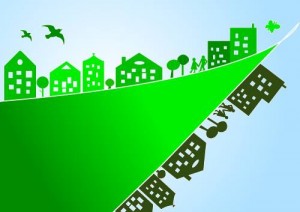Green Products
Green products aren't all they are made up to be - learn how you could be greenwashed.
Green products aren't all they are made up to be - learn how you could be greenwashed.
People are increasingly going green with product purchases, and it’s often the best choice if you wish to be environmentally friendly. However, there is a “dark side” to green products that some people might not consider.
It’s a controversial, emerging topic among those who are concerned about sustainability.
One of the chief considerations in this line of thinking is this: Buying a green product is generally better than buying one that isn’t, but if you really didn’t need the product, then it’s wasteful, anyway.
Often, a change in your own behavior is the better choice.
 A new article by University of California-Santa Barbara professor Roland Geyer and Loyola Marymount University professor Trevor Zink explores this issue in depth. Geyer is a professor of industrial ecology and green supply chain management, while Zink is a professor of sustainability and corporate social responsibility.
A new article by University of California-Santa Barbara professor Roland Geyer and Loyola Marymount University professor Trevor Zink explores this issue in depth. Geyer is a professor of industrial ecology and green supply chain management, while Zink is a professor of sustainability and corporate social responsibility.
Called “There’s No Such Thing As a Green Product,” the article is on the cover of the spring issue of the Stanford Social Innovation Review.
Among the points that Geyer and Zink make are the following.
The impact of products can be measured in different phases, including production and use.
Production. The production of every product or service has an impact on the environment and requires natural resources and also results in wastes and harmful emissions. In this area, many green products have as much of an impact as the making of other products.
Use. Green products are labeled as such because they are less harmful to the environment during the use phase. However, the authors argue that even this can be misleading. The standard for earning a green product label is not actually benefiting the environment, but merely having less of environmental impact than another company’s product.
And in some cases, the authors wrote, managers “simply look for one product attribute that can be labeled green and call a product green if it scores high in this attribute. This way bio-based materials (such as clothes made from natural fibers), products with recycled content, and hybrid cars are labeled green products even without genuine analysis.”
Comparing products on whether they are green or not can be misleading, as well. Sometimes no purchase at all – or changing our desires for certain types of products – is a better choice.
For example, a person might purchase a hybrid SUV and feel they are having less impact on the environment. However, not getting a SUV at all could be the better choice. As Geyer and Zink point out, in many cases a conventional compact car would get better gas mileage than a hybrid SUV.
Another is the example of a person who buys an energy-efficient electronic device of some sort – often encouraged by advertising – and feels they are having less of an impact on the environment because the device is green and others are not. However, as the authors point out, they would have less impact if they purchased “no gadget at all.”
The authors also note that while the light-emitting diode is the most efficient and longest-lasting source of light, consumer use of lighting products has actually increased as lighting has become more efficient.
The pair have a new concept, called Net Green, that they say better assesses a product’s environmental impact. They define it this way: “A business activity is net green if and only if it reduces overall environmental impact.”
In another words, a product would not be called green just because it’s better than the other company’s product. The goal is not to sell as many green products as possible, but to increase environmental sustainability of corporations.
Whether this type of definition is adopted or not remains to be seen.
But in the meantime, what’s an environmentally conscious consumer to do? Think through purchases and determine what you do – and do not – really need. While a green product can still be the best choice, sometimes no product is the most sustainable choice of all.